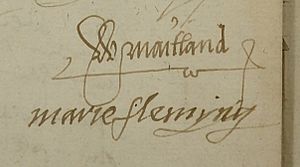Mary Fleming facts for kids
Quick facts for kids
Mary Fleming
|
|
|---|---|
| Born | 1542 |
| Died | January 1581 (aged 38–39) Scotland
|
| Nationality | Scottish |
| Known for | Lady in waiting to Mary, Queen of Scots |
| Spouse(s) | William Maitland of Lethington |
| Parent(s) | Malcolm Fleming, 3rd Lord Fleming Janet Stewart |
Mary Fleming (/ˈflɛmɪŋ/) (1542–fl. 1581) was a Scottish noblewoman and childhood companion and cousin of Mary, Queen of Scots. She and three other ladies-in-waiting (Mary Livingston, Mary Beaton and Mary Seton) were collectively known as "The Four Marys". A granddaughter of James IV of Scotland, she married the queen's renowned secretary, Sir William Maitland of Lethington.
Contents
Life
Mary Fleming was the youngest child of Malcolm Fleming, 3rd Lord Fleming, and Lady Janet Stewart. She was born in 1542, the year her father was taken prisoner by the English at the Battle of Solway Moss. Her mother was an illegitimate daughter of James IV of Scotland. Lady Fleming became a governess to the infant queen, also born in 1542, and the dowager queen, Mary of Guise, chose Lady Fleming's daughter Mary to be one of four companions to the young queen. Mary Fleming and Mary, Queen of Scots, were first cousins.
In France
In 1548, five-year-old Mary Fleming and her mother accompanied Mary, Queen of Scots, to the court of King Henry II of France, where the young queen was raised. .....
In 1554, Mary, Queen of Scots played the Delphic Sibyl and Mary Fleming was the Erythraean Sibyl in a masque performed at the Château de Saint-Germain-en-Laye, written by Mellin de Saint-Gelais.
Scotland
Mary, Queen of Scots, and her companions returned to Scotland in 1561 after the death of Francis II of France. The English diplomat Thomas Randolph recorded that the queen was consoled by Mary Fleming when she was disturbed by the discovery of the French poet Chastelard hiding in her bedchamber. After having "some grief of mind", the queen took Mary to be her "bedfellow".
On 26 May 1562 the four women attended Mary at the ceremony of the opening of the Parliament of Scotland. Thomas Randolph described the procession of "four virgins, maydes, Maries, damoyselles of honor, or the Queen's mignions, cawle [call] them as please your honor, but a fayerrer [fairer] syghte was never seen".
During the twelfth day of Christmas pageant in January 1564, Mary Fleming played the part of queen of the Bean.
On 19 September 1564, William Kirkcaldy of Grange wrote that the Royal Secretary, William Maitland, was showing an interest in Mary Fleming: "I doubt not but you understand me by now, that our secretary's wife is near dead, and he a suitor to Mrs Fleming, who is as fit for him, as I am to be Pope!"
Marriage to Maitland
Mary Fleming married the queen's royal secretary, Sir William Maitland of Lethington, who was many years her senior. The wedding was held at Stirling Castle on 6 January 1566.
The following evidence may suggest that the marriage was successful despite rumors that they were unhappy and that Mary wished to murder her husband:
- The wedding occurred after a three-year courtship that weathered ambivalent relations between Maitland and Mary, Queen of Scots, to whom Mary Fleming was a lady-in-waiting and had been since the age of five.
- Maitland was so infatuated with Mary Fleming that he wrote to William Cecil about it.
- The courtship was the talk of both the Scottish and English courts.
Mary Fleming and her husband were in Edinburgh Castle in 1573 when it was held by supporters of Mary, queen of Scots against an English army supporting the government of James VI of Scotland. She was captured with her husband when the castle surrendered on 28 May 1573. She was surrendered to Regent Morton and kept a prisoner in Robert Gourlay's House. Her husband was carried out of the castle on a litter because he was unable to stand or walk. He died at Leith on 9 June 1573 before his trial in the custody of William Drury. Mary Fleming wrote to William Cecil on 21 June imploring that the body of her husband, "which when alive has not been spared in her hieness service, may now after his death, receive no shame or ignominy". As a result, Queen Elizabeth asked Regent Morton to spare the body, which he did.
On 29 June 1573, and again on 15 July, she was ordered to return a chain or necklace of rubies and diamonds in her possession that had belonged to Mary, queen of Scots. The piece had been a pledge for money lent to William Kirkcaldy of Grange, captain of Edinburgh Castle. The piece was described as "a chayn of rubeis with twelfth merkis of diamantis and rubeis and ane merk with twa rubys in 1578.
Later life
Mary Fleming did not receive the restoration of Lethington's estate and properties until 1581 or 1582 by grant of King James VI, gaining a rehabilitation on 19 February 1584 for herself and her son. She was allowed the benefit of a property Maitland had given her, Bolton in East Lothian.
She had two children, a boy James, who later became a Catholic and lived in France and Belgium in self-imposed exile, and a daughter Margaret, who married Robert Ker, 1st Earl of Roxburghe. In 1581, Mary, queen of Scots asked Elizabeth I to grant Fleming safe conduct so she could visit the imprisoned queen of Scots. There is no evidence that Mary Fleming went. The last documents attributed to her are her letter to William Cecil and a letter to her sister discussing some bad feelings that existed between Fleming and her brother-in-law Coldingham.
She married secondly, George Meldrum of Fyvie.


